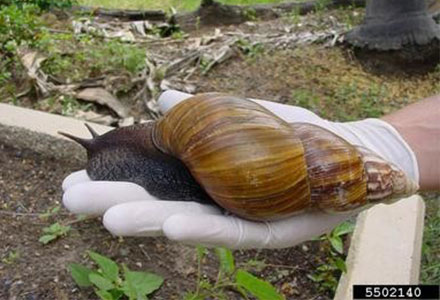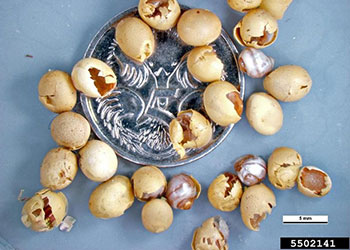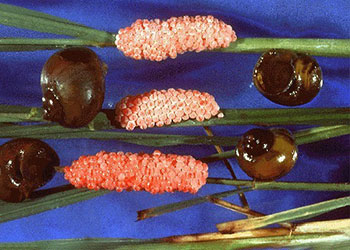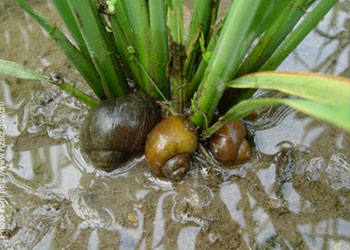PLANT PEST

Pest and Diseases Image Library, Bugwood.org.
Invasive snails (exotic species)
Exotic to Australia
Features: A number of snail species including the giant African snail which is large with a long and narrow pointed shell
Where they're from: Asia, Africa, North America, Central America, Caribbean, South America, Oceania
How they spread: Stowing away on imported goods or packaging; illegal importation as pets
At risk: Over 500 plant species are at risk from exotic snail species including fruit and vegetables; nurseries and rice; natural environment and humans
Giant African snail and golden (or channelled) apple snail are listed on both the National Priority Plant Pests and the National Priority List of Exotic Environmental Pests, Weeds and Diseases as they have the potential for significant plant industry/agriculture impacts and may also cause significant damage to our environment and social amenity.
Australian Chief Plant Protection Officer, Dr Gabrielle Vivian-Smith, provides an overview of the Giant African Snail
Download
| Document | Page | File size |
|---|---|---|
| Transcript DOCX | 1 | 12 KB |
If you have difficulty accessing these files, visit web accessibility for assistance.
Keep it out
Exotic snails can be highly invasive, impacting on agriculture, human health and biodiversity. While they’re slow moving they can spread widely by stowing away on plants and goods being moved around.
There are five species of overseas snails that have been identified as National Priority Plant Pests, with the giant African snail (Lissachatina fulica) topping the list. Its voracious (wanting to eat lots of food) appetite makes it one of the most damaging land snails.
More than 500 plant species would be targeted by the giant African snail, including most vegetables, legumes, ornamental plants, banana, citrus, even tree bark and the natural environment.
Snails also pose a threat to human health because they carry bacteria and parasites that can be transmitted if handled with bare hands or eaten.
Originally from East Africa, the Giant African snail is now damaging plants in many countries overseas. In part, its spread has been deliberate as people have taken snails home as a novelty pet. In the right climate, snails that escape become widespread. Giant African snails also emit an offensive smell when numbers build up.
Another snail on the list is a highly invasive freshwater snail, the golden or channelled apple snail (Pomacea canaliculata). A tropical fresh water snail native to South America, but was introduced into Asia for aquaculture and to the USA with the aquarium trade. It escaped into the broader environment and has now spread throughout eastern Asia. If it makes it to Australia, the snail could spread rapidly through creeks and rivers or during floods. It feeds on water plants, so it would alter the environment, and can devastate crops of rice and taro.
Caracollina lenticula (the lens snail), Massylaea vermiculata (the chocolate-banded snail) and the genus Monacha have been intercepted at the border. These snails are considered invasive pests that are likely to have a negative impact on Australia’s agriculture, livestock health and biodiversity.
Importing goods
To keep exotic snails out of Australia, never ignore Australia’s strict biosecurity rules.
Import shipments may need to be treated and certified, so before you import, check our Biosecurity Import Conditions system (BICON).
Giant African snails and golden or channelled apple snail are pests, not pets
Since exotic snails are likely to escape and spread causing problems for all kinds of plants and the environment in Australia, snails from overseas including giant African snails are prohibited. You cannot bring snails into Australia or purchase them online.
What to look for
Any snail on imported goods should be reported.
Giant African snails:
- are around six times larger than the common garden snail
- distinctive conical shell usually twice as long as wide
- have a long, narrow, cone-shaped shell that is usually 5 to 10 cm long, but can reach up to 20 cm
- vary in colour, but are usually light brown with alternating brown and cream bands on its upper whorls
- lay oval cream to yellow eggs about 5 mm across, in batches of 100-400.

The golden or channelled apple snail:
- is a fresh water snail
- it has a thin smooth shell
- is 3-6 cm in height
- shell colour varies from yellow-brown to greenish-brown or dark chestnut.
- It lays clusters of round eggs that are deep pink to orange in colour, above water on vegetation or bridges.


Where to look
Exotic invasive snails can arrive in Australia either as adults or as egg masses on imports through our airports or seaports, hitching a ride on:
- shipping containers
- cars
- soil and fertilisers
- machinery.
Sometimes snail trails may also be seen.
Importers
If you work around imported goods you need to look for snails, snail trails, and egg masses attached to:
- bags of ornamental fish
- crates
- machinery
- plant material
- shipping containers
- conveyances.
Nursery owners, rice growers and home gardeners
Look for any unusual snails.
What to do
If you think you’ve found an exotic snail:
- take a photo
- wearing gloves, collect snails or eggs and place them in a sealed container.
